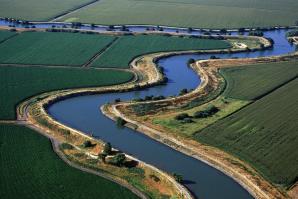For nearly 50 years California boasted the nation’s largest, most successful water system. Water flowed through the Gov. Edmund G. Brown California Aqueduct to San Joaquin Valley farms and southern California homes.
But the weak link in the system has always been the Sacramento-San Joaquin Delta. Immense pumps draw water from the north through the Delta then send it to thirsty users in the Bay Area, the Central Valley and Southern California.
As the state grew, the pumps ran faster and the Delta became weaker with a severely disrupted ecosystem and shrinking fish populations. Today, the condition of the Delta is so precarious — as is our supply of fresh water — that virtually all stakeholders agree something must be done.
That’s where the agreement ends. Water has become an ugly battlefield where many talk and few listen.
Instead, government leaders, local water agents, farmers, environmentalists, business people and Delta residents accuse one another of sinister motives, and most refuse to engage in collaboration and compromise. The problem now sits with the state Legislature, where we know partisanship and name-calling have become a fine art.
It gets worse. We now face the third year of consecutive drought, federal regulations that restrict water flow to protect fish populations, a state budget in tatters and a severe economic downturn.
Here’s some potentially good news: The situation has gotten so bad that more people are paying attention and more of them are calling for action — now. Even the federal government is taking notice by appointing a deputy interior secretary who will focus on the Delta as an ecosystem of national significance.
And we can find isolated examples of the collaborative solutions we need in the Delta. Take, for example, the San Joaquin River Restoration Program, which is meant to reverse years of irrigation-caused damage below the Friant Dam near Fresno.
Either we act now, or we set the stage for social and economic disaster in the years ahead.
After 20 years of wrangling and a lawsuit that made it clear restoration would be mandated, farmers and environmentalists hammered out an agreement. Farmers decided to get onboard and even help design the plan, rather than simply live with the consequences. Environmentalists saw the importance of involving farmers in the decisions. The federal government pitched in with financial help.
Working together, leaders in the San Joaquin Valley developed a comprehensive program, including water reduction and recycling, improved levies, new canals, added storage and continued research to improve engineering.
No one expects a perfect restoration of the river. Canals may need to carry water and transport salmon in some areas. But the end result will be a vastly improved ecosystem that guarantees water supplies (albeit somewhat reduced) for farmers and supports recreation and commercial fishing .
This is precisely the kind of process we need to see in the larger Delta: decisions based on good research, not paranoid assumptions. It requires the full and fair participation of all parties, those living in and around the Delta as well as those who depend on it for water.
Any plan must put conservation first. It can be achieved sooner at a much lower cost than any other alternative.
But while conservation is necessary, it isn’t sufficient. We need to improve levees, capture and store water when it’s plentiful and find a better way to move water through the Delta — canals, tunnels or some other method. We also need a stable funding mechanism with water users paying the biggest share.
We simply don’t have any choice. Water is a limited resource. Either we act now, or we set the stage for social and economic disaster in the years ahead.
Recommended For You

Change of Plans
Regional conservation efforts battle dwindling budgets and staff
The future of community growth in the Capital Region hinges on the fate of several habitat conservation plans slogging through the development pipeline.

Changing Tide
Turf and money battles continue over California water reform
It’s been about 20 months since lawmakers and former Gov. Arnold Schwarzenegger breathlessly announced a historic agreement called the Sacramento-San Joaquin Delta Reform Act of 2009, an ambitious plan to overhaul the state’s antiquated water system. Much has changed since then, but much more is still on the way.


